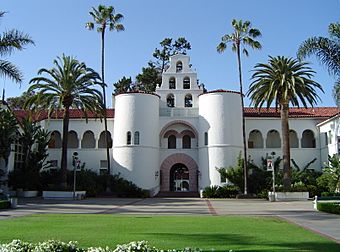Hepner Hall facts for kids
Quick facts for kids |
|
|
Hepner Hall
|
|
|
U.S. Historic district
Contributing property |
|

Hepner Hall on the SDSU campus
|
|
| Location | 5300 Campanile Dr., San Diego, California |
|---|---|
| Architect | Howard Spencer Hazen |
| Architectural style | Mission/Spanish Revival |
| Part of | San Diego State College (ID97000924) |
| Added to NRHP | September 4, 1997 |
Hepner Hall is a famous building at San Diego State University (SDSU). It was designed by Howard Spencer Hazen and finished in 1931. You can find it right in the middle of the SDSU campus. It's near the Malcolm A. Love Library and the main quad.
This building is home to many important parts of SDSU. It houses the School of Social Work. You'll also find the Department of Gerontology and the University Center on Aging here. Many professors have their offices in Hepner Hall. There are also lots of classrooms and lecture halls for students.
Contents
The Symbol of SDSU
Hepner Hall is like the main symbol of the SDSU campus. It has a special design called Mission Revival Style. This style includes an open bell tower and a big archway. Because of its unique look, it's the most photographed building on campus. The bells in the tower ring only once a year. This happens during the big graduation ceremonies.
Hepner Hall on the SDSU Logo
Hepner Hall is also a key part of SDSU's official logo. It's featured on the university's presidential seal. This updated logo and seal were first shown in 2004.
Building Design
You enter Hepner Hall through impressive doorways called portales. These doorways are decorated with cool turquoise and white tiles. Two large towers stand on either side of a special archway. This archway has a Mission-style bell tower on top. Inside the archway, the ceiling is vaulted and looks like a Moorish design. A fake wrought iron lantern hangs from its center.
A Look Back: History of Hepner Hall
Hepner Hall was one of the first buildings built on the SDSU campus. It was first known as the Arts and Letters Building. In 1976, it was renamed to honor Walter R. Hepner. He was the university's president from 1935 to 1952. The building is also listed on the National Register of Historic Places. This means it's an important historical site.




